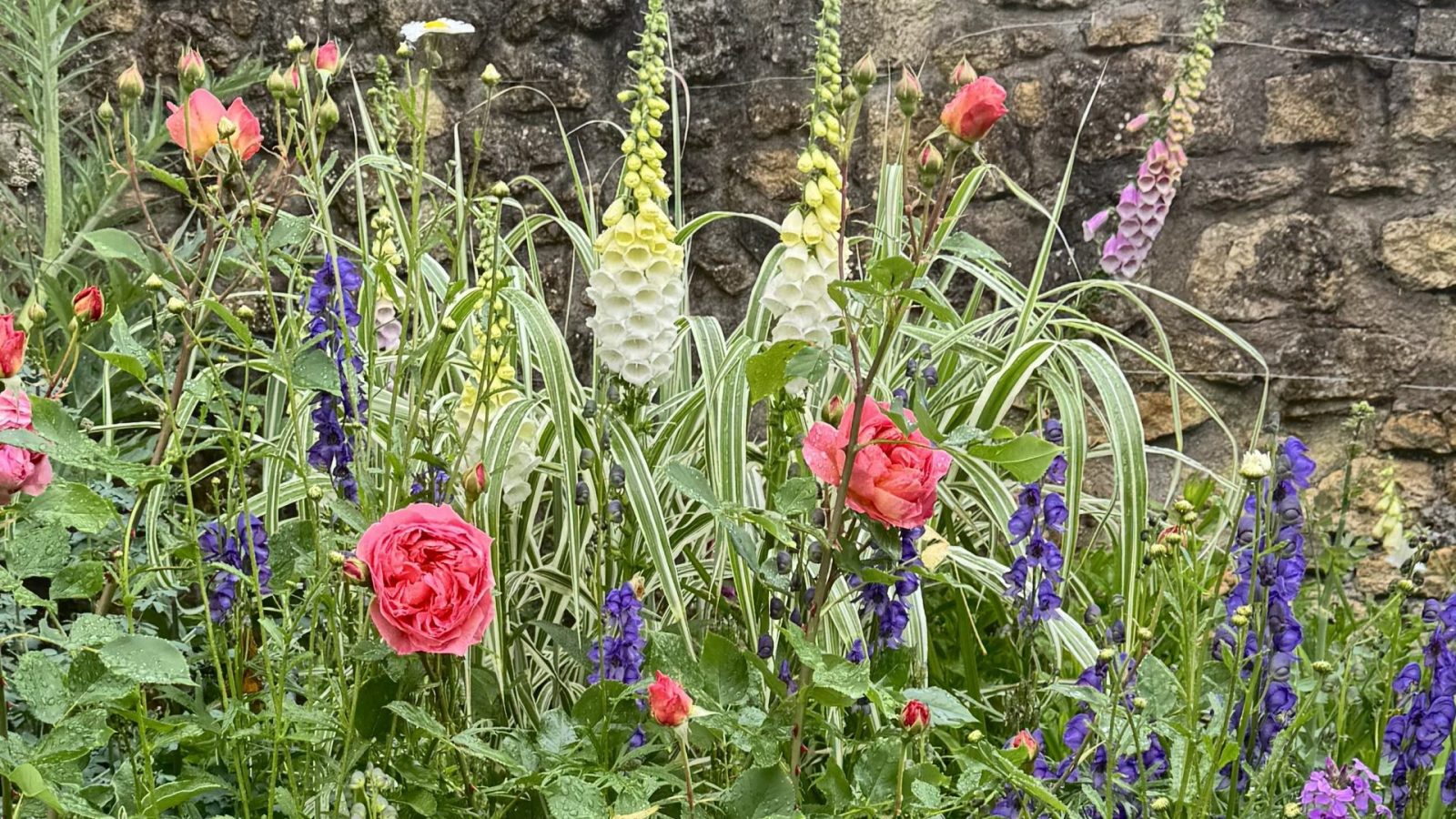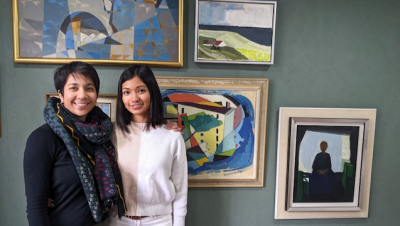Homes and Gardens / National Open Garden Scheme
Peer into people’s personal paradise for the summer
Across the UK, people have been passionately working away on their gardens to get them visitor-ready and share their little spot of paradise with the public.
Under the National Open Garden Scheme, thousands of people have unique access to more than 3,600 private gardens on a select number of days.
Throughout the day, the host provides refreshments, information and entertainment as hundreds of visitors flow through their gardens, staying for several hours to soak in the natural beauty carved by these green-fingered gardeners, who sometimes also sell plants.
is needed now More than ever
Beyond a lovely day out, ticket proceeds go to a number of charities.
In 2024, £74m was raised for nursing and health charities. While open days are limited, some gardens – including several in Bristol – are open by arrangement.
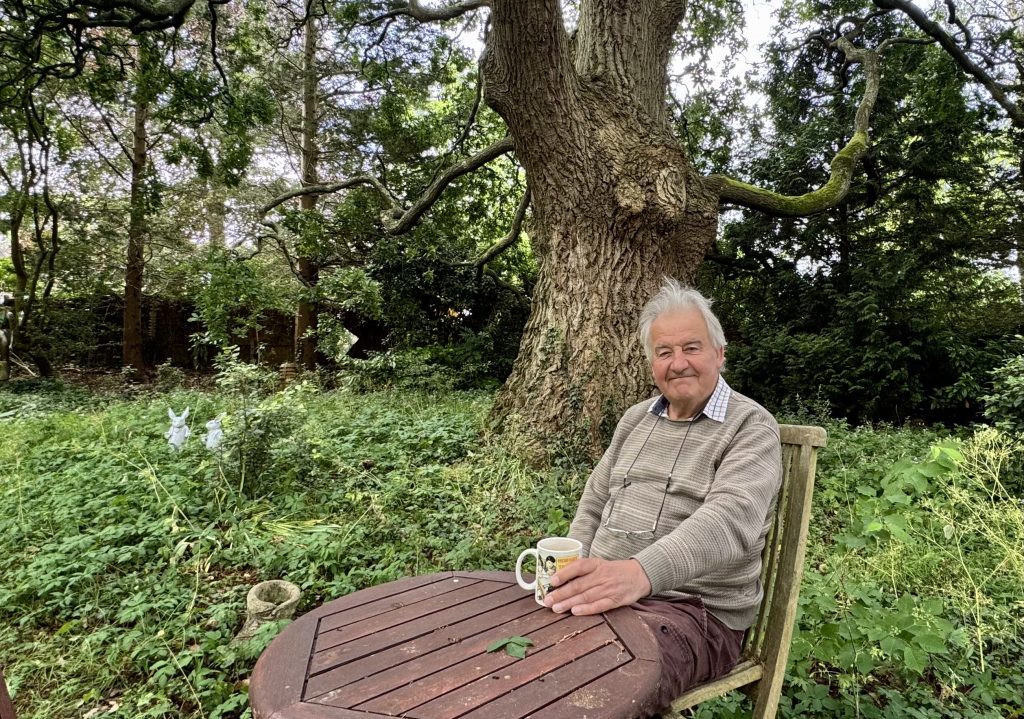
“It’s very much a garden party. It’s not that you just come and view it, you’re hosting people,” says Malcolm – photo: Hannah Massoudi
Lucombe House, Druid Stoke Avenue, Stoke Bishop
Lucombe House was built in 1907 and the current owner Malcolm Ravencroft came into possession of the property in 1987.
When purchased, the garden comprised a large lawn area with beds mostly of laurel to the left and overgrown shrubs to right.
Following storms in 1987, a large conifer that fell down was replaced by an Atlantic Cedar, marking the start of changes in the garden.
2009 is when the garden at Lucombe House was transformed with the help of landscape gardner, Carolyn Marks.
An oak tree is the standout feature of the garden and remains steadfast in its position.
The tree is almost 260 years old and is a hybrid of a Turkey oak and a Cork oak which was first identified in 1762 by William Lucombe who raised saplings at his nursery in Exeter.
The one in this garden is one of the first samplings planted in the South West and now has a girth of 5.5m. All four of Malcolm’s sons climbed it as young boys.
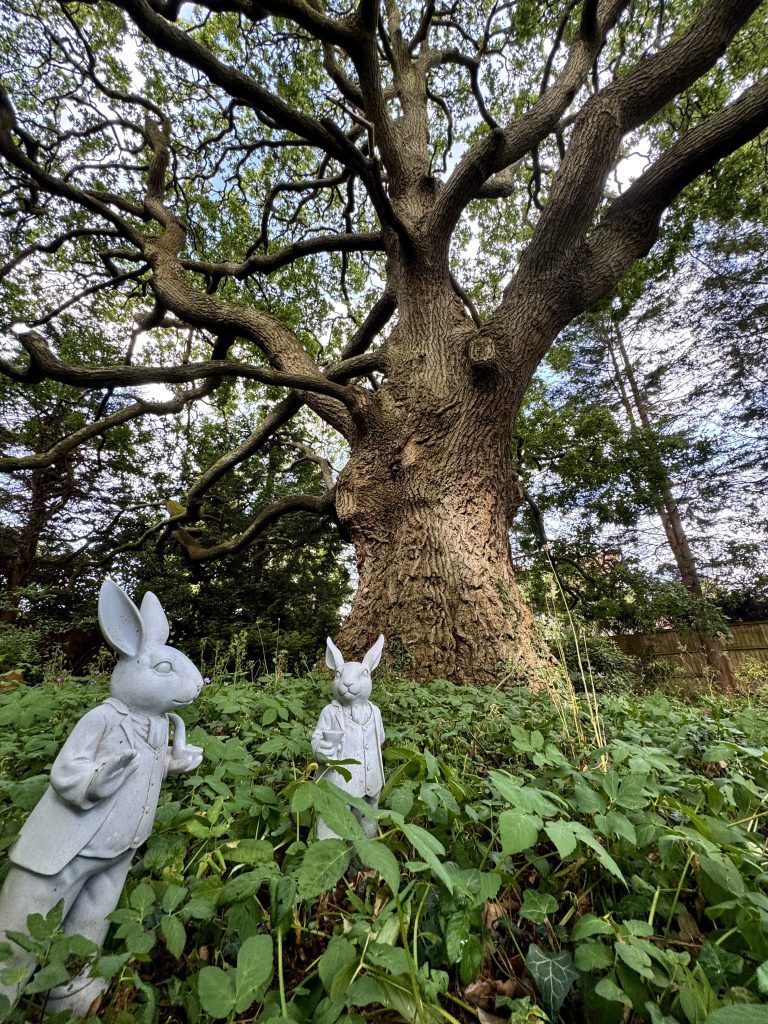
“We have a group of people who come just to hug the oak” – photo: Hannah Massoudi
The laurel was mostly removed apart from boundary hedging.
The area to the left of the oak was planted with about 30 English trees including silver birch, ash, hazel and a copper beach.
Malcolm says they were trying to create a canopy that made it feel like you’re walking through a woodland, with ferns, Solomon’s seal and bluebells (usually indicative of an ancient woodland) covering the floor, reaching towards the dappled light.
Malcolm says: “When you’re here with the birds singing, you don’t hear the cars, you could actually be in the countryside.” When Malcolm’s four young grandchildren come to visit this becomes where the Gruffalo lives.
The make believe continues; littered through the woodland like garden are obscure objects like mini doors, a pair of stone rabbits, mannequin limbs, a glitter ball and a pile of rocks that look eerily like something has been buried.
He claims to visitors that it’s a cairn for his pet dog, except he’s never had a dog. But it’s all part of the fun.

There is a torso of a mannequin that Malcolm likens to Venus de Milo – photo: Hannah Massoudi
A mirrorball was put in place so people didn’t hit their heads and Malcolm picked up the mannequins from a charity shop as a joke feature.
There are many different facets that attract people to Malcolm’s garden: “People will be amazed by the plants and then the kids come round and say, ‘Wow there’s rabbits. Dad, dad, dad, come and see those rabbits!”
The area to the right of the oak tree was planted with a variety of shrubs and flower beds.
There are what Malcolm calls pigeon cherries as the pigeons who sit on the cherry trees munching away, fly over and spread the seeds across the garden.
This area of the garden continues to be developed and will be the focus for future work.
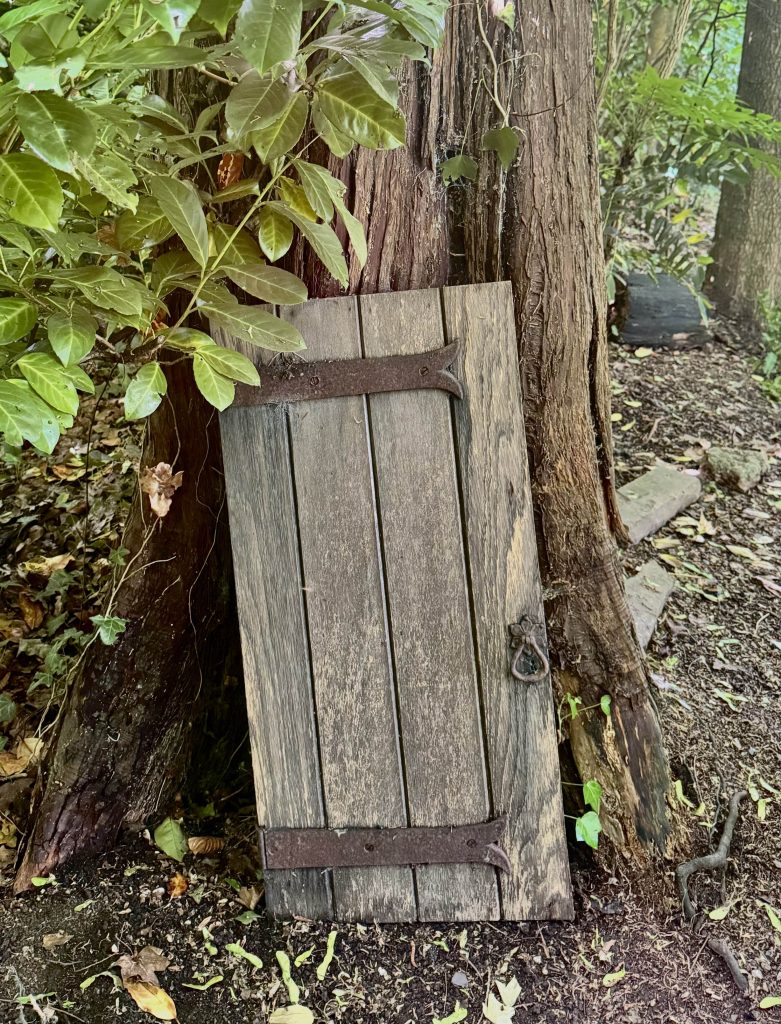
Whimsical details such as doors line the pathway to adventure – photo: Hannah Massoudi
“This lawn is full of 30 odd people all sitting there having their teas. And are they looking at the garden? I mean, who cares? They come here, and they just enjoy it, and that’s what it should all be about.”
Malcolm has been a part of the National Open Garden Scheme for around 15 years.
When he first started doing them his knowledge was not quite what it is today but his humour was ever-present.
Visitors would enquire about the plants and get an answer like ‘puplus fluffycus’ (it was actually a Persicaria).
Now, however, he is much more familiar with the plants in his garden.
“You learn as you go along,” he says.
He applies this approach to all things in his garden and he says the “one thing I have learned is that plants decide where they want to live.
“It doesn’t matter what you put in the ground, the plant and the ground will decide.”
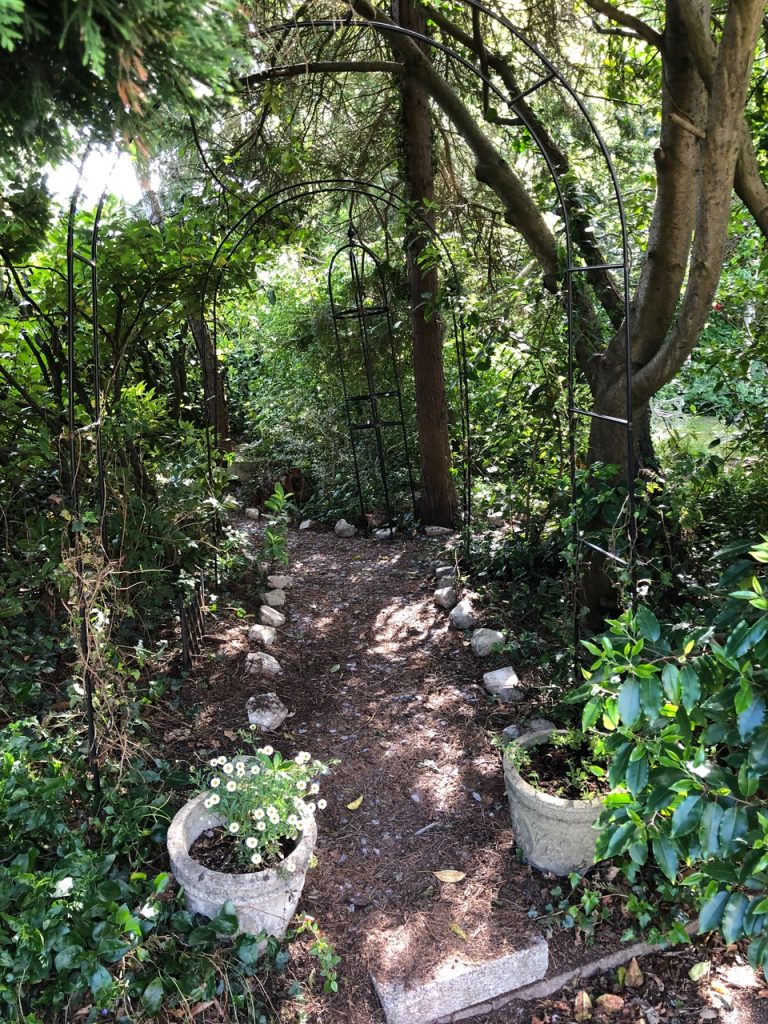
The local scouts brigade enthusiastically help Malcolm with the open days – photo: Malcolm Ravencroft
Malcolm’s rules for a happy garden are firstly, to accept the plants decide whether they’re happy or not.
If they’re not happy, move them. Secondly, don’t assume things have died. Because plants really want to live. Leave them alone and see what happens.

“My husband is very patient and generous. He also has now learned to go “how lovely,” instead of “where are you going to put that?” – photo: Hannah Massoudi
4 Haytor Park, Coombe Dingle
Pat Prior has encapsulated her 25 years of opening her garden in a scrapbook.
Pat moved from Oxford to Bristol with her husband and 18-month-old baby boy.
For a while she was able to commute to her job as a research scientist but it became unsustainable after a while.
But the job she left bridged her past with her future, as her passion for gardening was ignited by a colleague and friend who she describes as a “super, super gardener”.

The Echeveria plant is thriving, as it rosy hued flowers bloom – photo: Hannah Massoudi
Sharing a car to work, Pat regularly came to her friend, Jo, seeking advice for whichever houseplant was now in dire straits.
She demonstrates in an exaggerated tone how she would wail:”Jo, my plant has died. What do I dooooo?”
But she eventually got the bug. “I found I wanted to be outside all the time.”
Before long, she had gone into business with her friend.
She’s stopped now but her friend continues on, she adds, “There comes a point when you really don’t want to be crawling under somebody else’s bush in the pouring rain.”
During the time they were doing their garden design, it was another pivotal interaction with a friend that Pat was encouraged to participate in the National Open Garden Scheme.
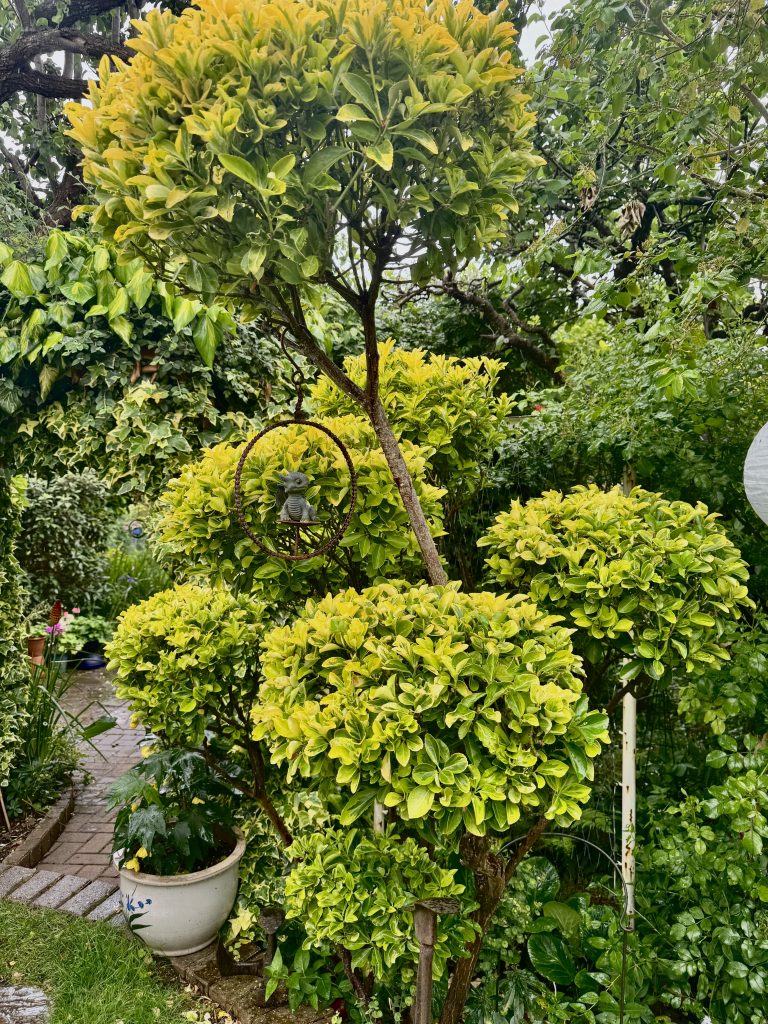
Pat particularly likes Blaise Nursery for their quality and their coffee shop – photo: Hannah Massoudi
She has a “dream team” that helps out on open days.
“They have a ball, eat biscuits and cakes, drink tea and just generally have a lovely afternoon.”
There are four of them, two are very knowledgeable about plants, and ironically the other two have no interest in gardening whatsoever.
Perhaps it’s being outdoors that draws them, or perhaps the lunch, nibbles and a glass of prosecco at the end of the day.
Open days are always successful, with a record taking of £2,000.
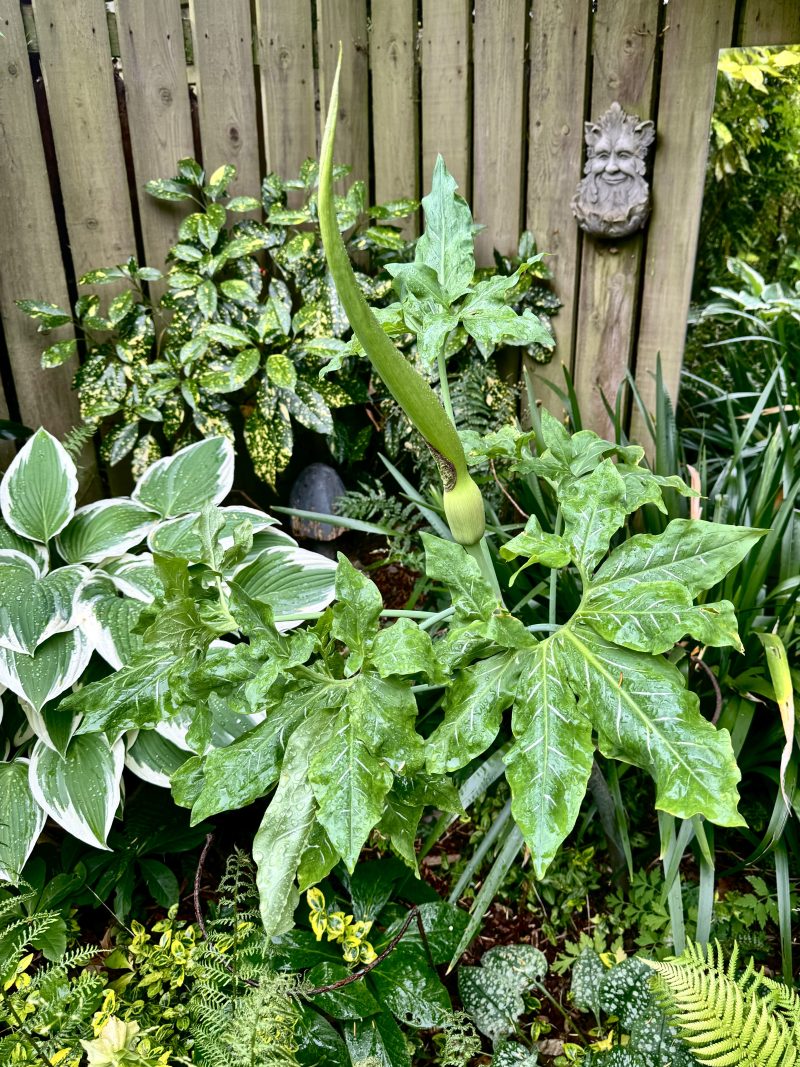
The Dragon Arum’s leaves have unique shaped leaves – photo: Hannah Massoudi
Summer Jasmine lines the patio creating a dreamy aroma for visitors to step into.
In one corner you have a pebble water feature and in the other, succulents arranged on small wooden steps.
There is a noticeable theme throughout the garden; in every corner of the garden, wherever you look there is a dragon, directly in front of you, hiding under leaves or several in the periphery.
For Pat, this theme started with Cariad, a Welsh dragon gifted to her by a friend.
It becomes a charming game, trying to spot all the dragons, with Pat putting her estimate of resident dragons at more than 70.
Continuing the theme, I’d be remiss to not mention the Dragon Arum sitting in the back of the garden. The exotic plant has been a staple feature of the garden for many years with its purple spotted stems.
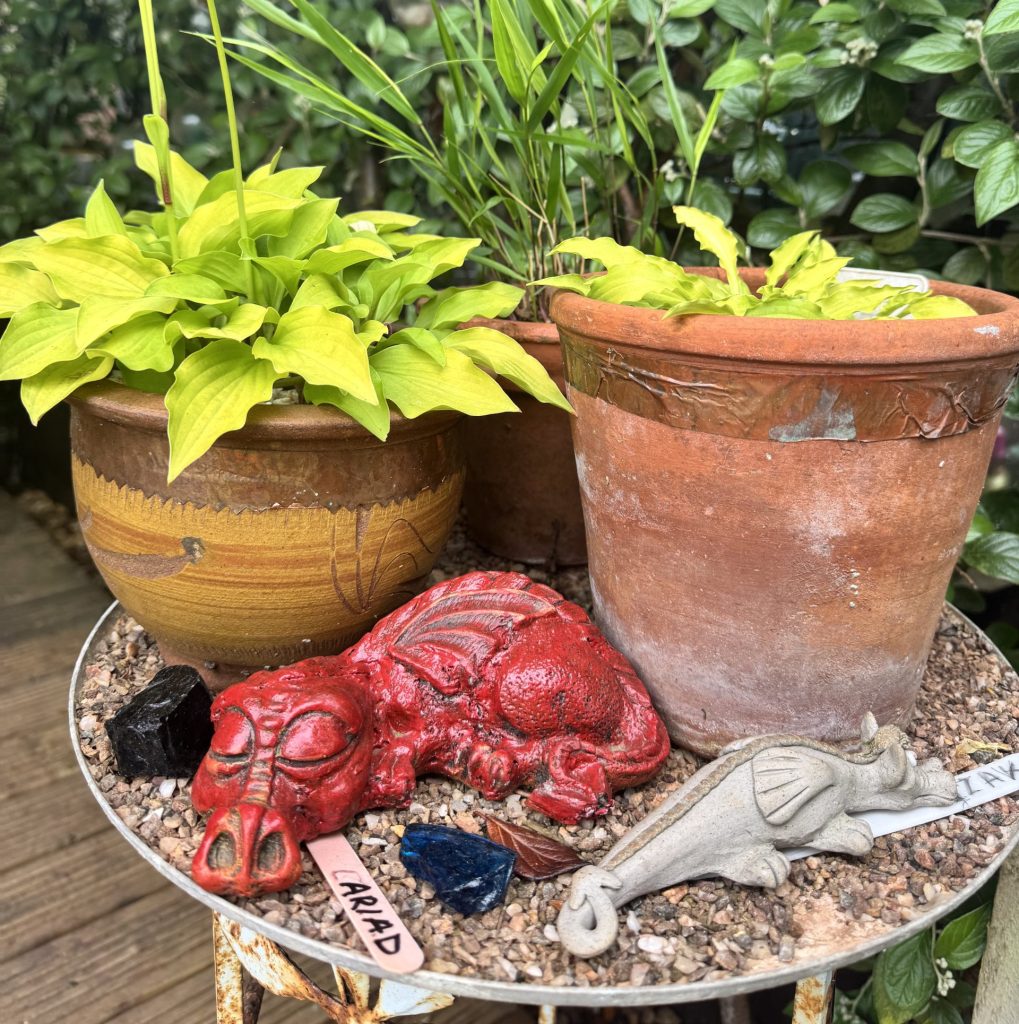
Cariad – The dragon that started it all – photo: Hannah Massoudi
In this garden there are also many repurposed and upcycled items.
Pat’s adult sons’ old Doc Martin boots line the fence.
Many of the succulents live in the little dishes that fit inside a pressure cooker.
Other items she has actively sourced such as the bike wheels that line the pond which create a barrier to prevent visitors from getting too close.
There used to be a bike shop on Henleaze Road called Harvey’s Cycle Exchange, and one day Pat went in to see if they had any bike wheels going and without hesitation they gave her as many as they could.
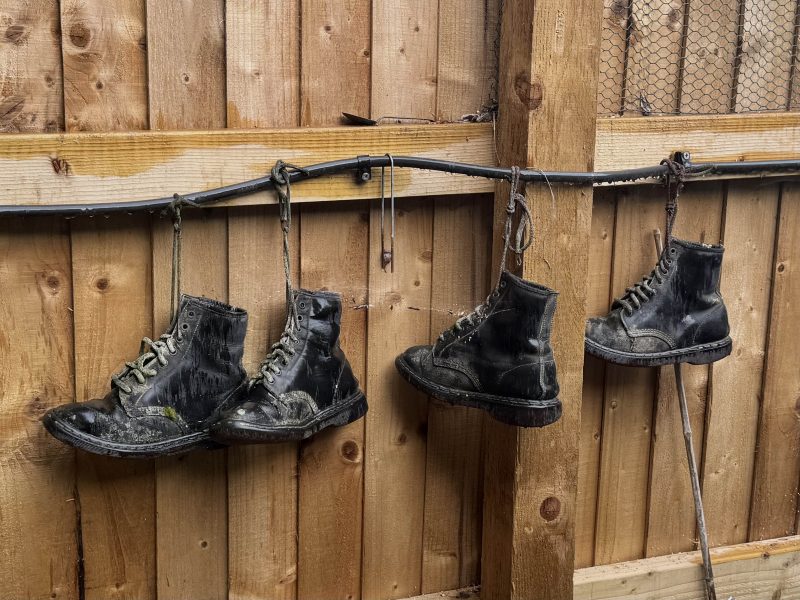
It’s hard to not see potential in everything – photo: Hannah Massoudi
The garden is also wildlife friendly, the pond attracts newts and frogs.
A fox takes a nap in the shrubs, flattening the surrounding plants, much to Pat’s dismay.
They get an array of birds and insects and have even seen badgers in the garden.
But one bird is less welcome: “I get really cross about the pigeons. There’s a particular plant called Elisha’s Tears, which has hollow stems and then very dangly flowers with dark purple berries, which the pigeons like.”
The problem, she tells me, is “because the stems are hollow, very fat pigeons sit on them.
They bend them, and of course it’s like if you were to bend a copper pipe, you can’t bend it back.”
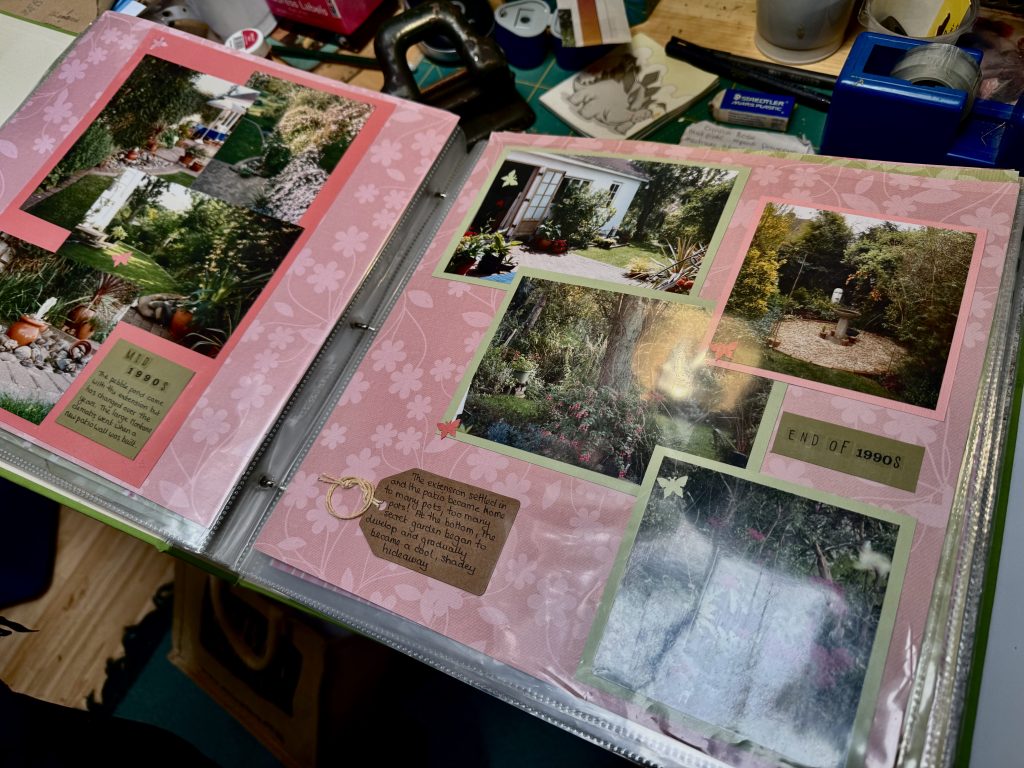
Pat has condensed 25 years of opening her garden into one book – photo: Hannah Massoudi
So she has items hanging near them in an attempt to discourage them, as well as aluminium foil on the top of the garage that make noises when they sit on it.
“It’s a constant battle. If it’s not slugs and snails,” she sighs.
But she hasn’t resorted to artillery yet, she jokes.
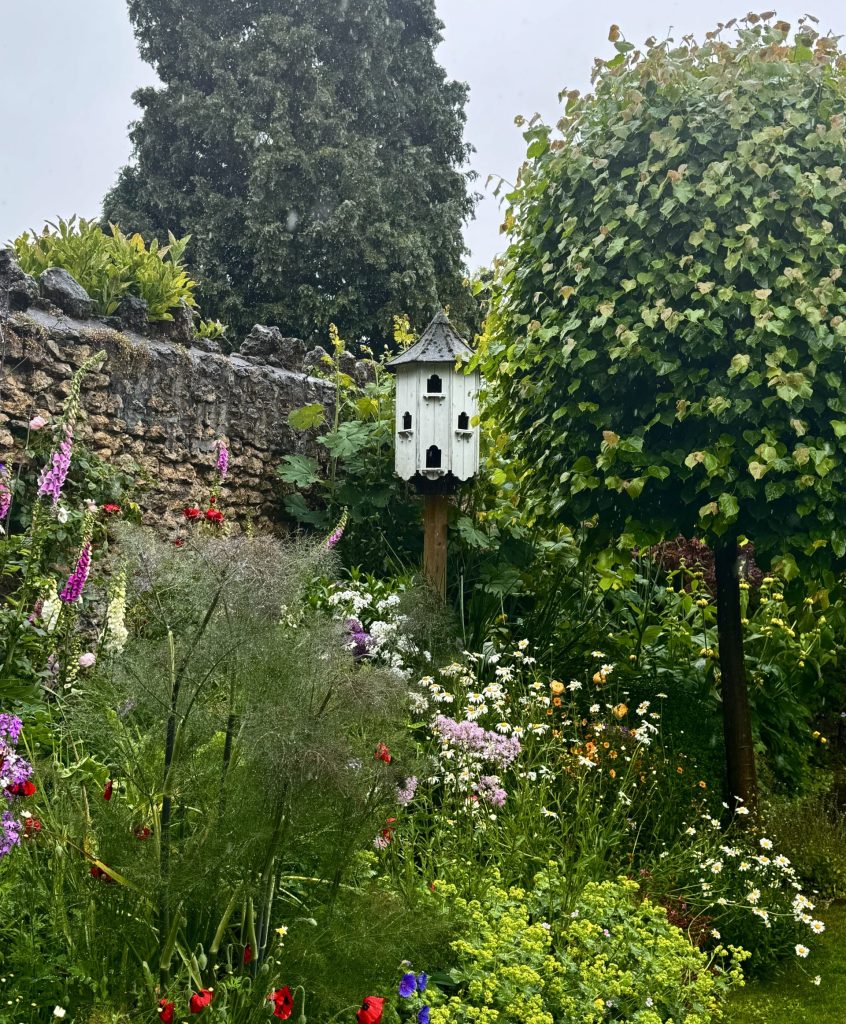
Not a single spot of bare ground can be seen through the plants – photo: Hannah Massoudi
81 Coombe Lane, Stoke Bishop
A lot of organising goes on behind the scenes to orchestrate the open days.
As an assistant County organiser, Karl Suchy is one of the people responsible for a handful of gardens throughout the area.
Responsibilities such as admin, IT and sourcing stationary such as posters advertising the gardens or warning of ponds and slippery surfaces.
Karl also puts his own garden on display.
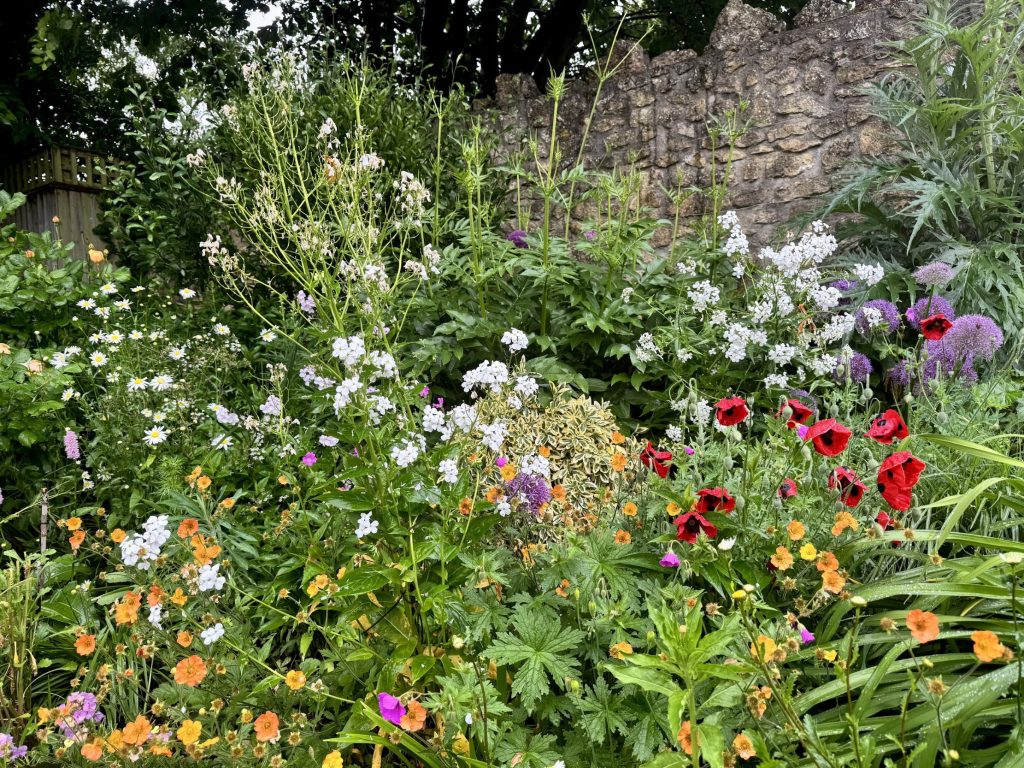
The Ladybird Poppy is Karl’s signature plant. He says it just gives the borders a “pop” of colour – photo: Hannah Massoudi
Now retired, Karl spends a lot of time tending to his garden and teaching others how to take care of plants.
While he considers himself an amateur, he first learnt to garden at Great Dixter House & Gardens (produced by the legendary gardener Christopher Llloyd) in East Sussex.
He quips that he’s a “great plagiariser” when it comes to what influences the design of his garden.
When he first moved in, there were two lawns either side of the drive, but there weren’t any flowers. It’s when his wife, who does a bit of flower arranging, said there was nothing for her to pick in the garden.
Now of course that isn’t the case: filled with a beautiful variety of wildflowers and plants, from Foxgloves, roses, Aliums and his signature plant: the Ladybird Poppy.
The rows of mixed flowers are surrounded by a large stone wall, with a multi-room bird house rising above them.
The back garden is tropical themed with giant banana plants and a medium sized pond filled with Koi that greedily flock to every new visitor in search of food.

A duck presides over the Koi pond and ill-behaved fish – photo: Hannah Massoudi
It’s well known that activities like gardening are great for wellbeing. Karl too says it gives him “great pleasure” to garden. “If I’m a bit stressed. If you come out and start gardening, you just feel better.”
His garden has lots of lawn space and a seating area, perfect for parties and hosting.
“I like showing the garden to people and sharing them with people.”
On their open days, more than 300 people pass through the garden.

Roses good enough for the Queen of Hearts – photo: Hannah Massoudi
“It does become a bit of a community. Obviously, my friends come and support me, but all the local people who visit.
“People stay a long time. Some people live in flats and so they’ll come there, and because we’re open for four hours, they’ll spend the whole four hours here and that’s nice… I think that’s the test of a garden.
“Do I want to sit and have a cup of tea or a glass of something in the garden and chat with my friends?”
To find out more about the National Open Garden and find an open garden near you, head to findagarden.ngs.org.uk. Or if you would like to participate in the scheme visit ngs.org.uk.

This article is taken from the July/August 2025 Bristol24/7 magazine
All photos: Hannah Massoudi
Read next:
 Our newsletters emailed directly to you
Our newsletters emailed directly to you